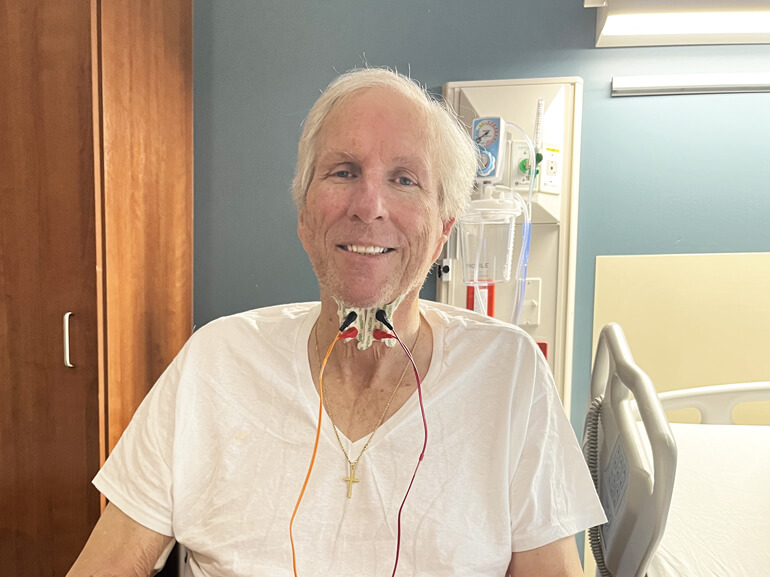David's Story

When David Cunningham wasn’t selling cranes or associated services nationwide, he enjoyed touring plantations, playing golf and watching crime shows. One evening he had trouble swallowing his dinner, but he had no throat or stomach pain. He decided to just go to bed. However, he woke up with a headache and his wife convinced him to go to the local emergency room, Ochsner Westbank.
There, the right side of David’s face began to droop and his speech was slurred. Doctors diagnosed him with a small stroke, vocal cord paralysis and pneumonia. Because David was unable to swallow, a feeding tube—called a PEG tube—was inserted directly into his stomach to provide nutrition. When he was medically stable, David chose to continue his recovery at Ochsner Rehabilitation Hospital because of its excellent reputation in helping stroke patients recover.
Upon arrival at Ochsner Rehabilitation Hospital, David was assessed by the care team. They conducted a swallowing test, a FEES, which showed no improvement in his dysphagia; weakness of the swallowing muscles which prevented him from ingesting food or drink safely. David also required assistance to stand and walk with a rolling walker, and accordingly, his therapists identified regaining strength, balance and endurance as key elements to his independence.
Speech therapy began working with David to strengthen his swallowing muscles. He worked on his swallowing while receiving electrical impulses via Vital Stim therapy. The electrical stimulation facilitates contraction to help strengthen and retrain the swallowing muscles. A few weeks later, David successfully mastered his swallowing test and was able to start drinking and eating chopped food safely.
Occupational therapy helped David address his activities of daily living. Initially, he needed help with toileting, dressing, bathing and transferring positions. He participated in intense occupational therapy to improve his balance, standing endurance and self-care independence. David participated in various activities that incorporated fine motor skills exercises while standing to improve his ability to brush his teeth, toilet, dress and eventually return to golf.
In physical therapy, David did squats, calf raises and cone taps in front of a mirror to enhance his balance. His therapist continued to advance his therapy by adding side steps and lunges. Under close supervision, David was soon able to practice walking without an assistive device.
After two weeks of rigorous therapy, David was ready to discharge home—he couldn’t wait to taste his wife’s home cooking. He had put in much effort to get to this point and could now walk independently with a rolling walker in the home and with supervision on more uneven surfaces outside the home. Additionally, he had mastered going up and down stairs independently.
David could also manage his own toileting and dressing—only requiring supervision with bathing and transfers. He planned to tackle the latter two activities with home health occupational therapy. In the meantime, he looks forward to resuming his favorite hobbies.
Before leaving Ochsner Rehabilitation Hospital, David shared that the therapists exceeded his expectations and had this advice for other patients facing a similar journey: “Let people help you.”